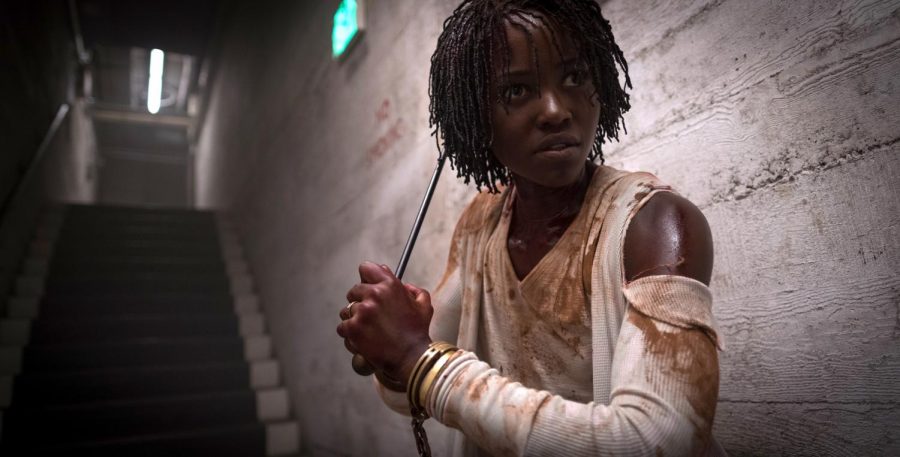Duality exposes horror in “Us”
‘Us’ delivers thriller full of symbolism, dives into American class dualities
Mar 27, 2019
Social discourse inevitably inspires a discussion of class and poverty as the two issues most Americans agree are in a state of disrepair.
These conversations often devolve into a “us versus them” dichotomy, making victims of poverty seem different or less worthy than those who are more fortunate.
Under scrutiny, this mirage of care fades away as people write essays on how to fight poverty and then refuse to acknowledge the humanity of a homeless person with something as simple as eye contact.
In “Us,” Jordan Peele offers a thought-provoking examination of class and America’s divisions, while still creating a gory and fun horror flick with an 80s flair.
Similar to his Academy Award-winning film “Get Out,” released in 2017, Peele’s sophomore directorial effort uses horror and suspense to make an emphatic social statement.
In “Get Out”, he examines racism and its manifestation — even in liberal communities.
In “Us” Peele shifts his focus to all Americans and their relationship, or lack thereof, with victims of poverty.
The film begins with a short quote talking about the network of thousands of miles of tunnels that line America’s underbelly.
A television begins playing an ad for “Hands Across America” — a benefit campaign in 1986 where people from all walks of life attempt to lock hands across the United States as a show of unity.
As strangers interlocked hands, then President Ronald Reagan widens the disparity gap, primarily through his war on crime and drugs campaigns.
Each image in the opening shots of “Us” is densely packed with hints setting up plot points alongside subtle nods to the 80s and other horror films.
Like numerous moments in the film, Peele’s trademark attention to detail and method of rewarding hawk-eyed viewers is on display.
Adelaide Wilson (Lupita Nyong’o) and her family travel to their vacation home in Santa Cruz, California. The relatively well-off family has the luxury to be more concerned with its new boat having enough space for the family rather than putting food on the table.
Even though the Wilson family is well-off, it’s interesting that Peele makes sure their white friends, Kitty (Elizabeth Moss) and Josh (Tim Heidecker) have more money.
It’s an interesting commentary on black and white upper middle-class structure, a tertiary theme underlining the film.
The Wilson family is the most grounded part of the production as they are an every day middle-class family.
Gabe Wilson (Winston Duke) is the affable father who acts as consistent comedic relief. Their two children, Zora Wilson (Shahadi Wright Joseph) and Jason Wilson (Evan Alex), are a likable duo representing a cellphone obsessed teenage sister and her quiet younger brother.
However, unknown to the Wilson family, the tunnels referenced in the intro are inhabited by the Wilson’s murderous doppelgangers.
As the story moves on, the film goes from a fun home invasion horror flick to raising the stakes to that of an extinction-level event — if only for the Wilsons.
Adelaide’s doppelganger, Red (Lupita Nyong’o), is one of the supposed millions of “tethered” individuals who reside in these tunnels. They are copies, bound by a soul, to those above ground.
However, they reside away from sight or knowledge.
Nyong’o delivers an Oscar-worthy performance as Adelaide/Red. Her performance as Adelaide is filled with mysterious hints as her story unfolds while playing an empathetic mother figure who fights, tooth-and-nail, to protect her family.
As Red, she is downright terrifying.
Her voice sounds like a haunted house’s creaky door and her strained face and sudden, arachnid-like movements are hair-raising.
The tethered surprisingly end up being sympathetic villains with clear motivations. They are victims of a system that America created and Red is a monster Adelaide created.
The tethered are forced to mimic the actions of their soul-bonded counterparts above ground leading to trauma.
For example, while Adelaide’s second baby necessitates delivery via C-section, Red is forced to deliver her baby without such luxuries.
As the amalgamation of traumas mount, the tethered escape their underground existence, donning red coveralls and murdering their soul-bonded counterparts with golden scissors.
“Us” isn’t grounded much in reality and Peele cashes in on the trust he earned with audiences through “Get Out” to ask for some leaps of faith when viewing.
The premise with the tethered has holes in logic that reveal themselves later in the film.
Peele seems to take a classic sci-fi approach to the film where broad concepts are more important than making sure every question seamlessly fits with a carefully constructed answer.
Peele nails the broad concepts of class through the film’s exaggerated narrative and beats. “Us” also nails the subtler ideas well.
The extraordinary concept illustrates the false dichotomy of us versus them.
As Red rises above her social class, she is still clearly holding the marks of past trauma by her actions, erratic movements and tone of voice.
While she is inhabiting the above-ground world, her mannerisms are still affected by an upbringing of trauma that mirrors the generational trauma felt by minorities in America.



